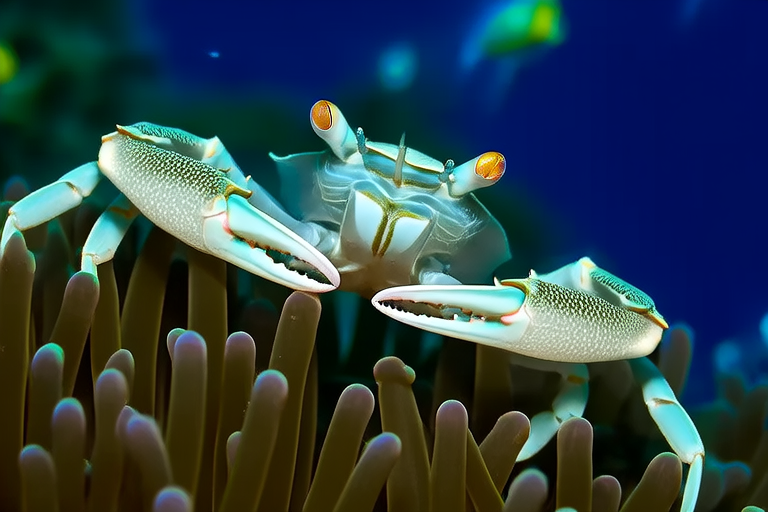Meet the Tiny Pea Crab: Nature’s Hidden Gem
The world beneath the waves is teeming with life, from the vast and majestic to the tiny and often overlooked. Among these small but fascinating creatures is the pea crab (Pinnotheres sp.), a diminutive crustacean that has captivated marine biologists and nature enthusiasts alike. Despite its petite stature, the pea crab plays a significant role in its ecosystem and offers a window into the intricate relationships that define marine life. This article delves into the world of the pea crab, exploring its unique characteristics, habitat, behavior, and the challenges it faces in the modern world.
Introduction to the Pea Crab
The pea crab, as its name suggests, is one of the smallest crabs in the world, typically measuring no more than half an inch in length. Its body is compact and rounded, resembling a green or brown pea, which gives it its common name. The pea crab belongs to the family Pinnotheridae, and there are over 30 known species distributed across various marine environments. These crabs are found in both temperate and tropical waters, making them a truly global phenomenon.
Habitat and Distribution
Pea crabs are primarily found in coastal regions, where they inhabit a variety of marine environments, including seagrass beds, mangrove swamps, and coral reefs. They are particularly fond of areas rich in sessile (non-moving) organisms, such as sea anemones, sponges, and bivalves. These habitats provide the pea crab with both shelter and food sources, allowing it to thrive in diverse ecological niches.
In addition to their preferred habitats, pea crabs have adapted to live in close association with certain host organisms. Many species of pea crabs are obligate symbionts, meaning they cannot survive without their hosts. For example, some pea crabs reside within the gill chambers of bivalve mollusks, such as scallops and clams, while others make their homes inside the tentacles of sea anemones. These symbiotic relationships are crucial to the survival and success of the pea crab.
Symbiotic Relationships
The symbiotic relationship between pea crabs and their host organisms is one of the most fascinating aspects of this tiny crustacean’s life cycle. In many cases, the pea crab benefits from the protection and resources provided by its host, while the host may also gain some advantage from the presence of the crab. For instance, pea crabs that live within the gill chambers of bivalves can help clean the host’s gills by feeding on debris and parasites, potentially improving the host’s respiratory efficiency.
Pea crabs that reside within sea anemones benefit from the anemone’s powerful stinging cells, which protect them from potential predators. In return, the pea crab may assist the anemone by preying on smaller organisms that could otherwise harm the anemone. This mutualistic relationship demonstrates the delicate balance that exists within marine ecosystems and highlights the importance of biodiversity.
Behavior and Reproduction
Despite their small size, pea crabs exhibit a range of behaviors that are both intriguing and essential to their survival. Mating rituals, for example, are particularly interesting. Male pea crabs are known to engage in elaborate courtship dances, waving their claws and performing other displays to attract females. Once a mate is secured, the pair will spend several weeks together, with the male guarding the female during the critical egg-laying period.
Female pea crabs carry their eggs on their abdomens until they hatch. The larvae are released into the water column, where they undergo a series of developmental stages before settling on a suitable host. This process is crucial for the continuation of the species, as it ensures that future generations find appropriate environments to grow and thrive.
Threats to the Pea Crab
Like many marine species, pea crabs face numerous threats in today’s changing world. Habitat destruction, pollution, and climate change all pose significant risks to their survival. Coastal development and the degradation of seagrass beds and mangroves can disrupt the delicate ecosystems that pea crabs rely on for shelter and food. Additionally, changes in ocean temperature and acidity can affect the availability of suitable hosts, further complicating the pea crab’s ability to reproduce and thrive.
Fishing practices also present a challenge. Many species of pea crabs live within commercially important bivalves, such as scallops and clams. As a result, they can be inadvertently caught in fishing nets, leading to declines in local populations. Conservation efforts aimed at protecting marine habitats and promoting sustainable fishing practices are essential to safeguarding the future of the pea crab and the ecosystems it calls home.
Why the Pea Crab is a Hidden Gem
The pea crab is a true hidden gem in the world of marine biology. Its small size belies its significance within its ecosystem, where it plays a vital role in maintaining the health and balance of marine communities. By studying the pea crab, scientists gain valuable insights into the complex relationships that exist between different species and the importance of preserving biodiversity.
Moreover, the pea crab serves as a reminder of the incredible diversity of life that exists in our oceans. Each species, no matter how small, contributes to the overall richness and resilience of marine ecosystems. Encouraging awareness and appreciation for the pea crab and similar organisms helps foster a greater understanding of the interconnectedness of all living things and underscores the need for conservation efforts to protect these fragile environments.
In conclusion, the pea crab is a remarkable creature that deserves recognition for its unique characteristics and vital role within its ecosystem. From its symbiotic relationships with host organisms to its complex mating behaviors, this tiny crustacean offers a glimpse into the wonders of marine life. By learning more about the pea crab and the challenges it faces, we can better understand the importance of protecting our oceans and the myriad forms of life they support. Let us celebrate the pea crab as a symbol of the beauty and complexity of nature, and work together to ensure its continued existence for generations to come.
